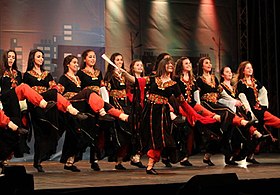Dabkeh
| Dabke | |
|---|---|

Palestinian girls dancing traditional Dabke
|
|
| Medium | Circle dance and line dancing |
| Types | Variations |
| Originating culture | Arab |
Dabke (Arabic: دبكة also spelled Dabka, Dubki, Dabkeh, plural Dabkaat), is an Arab folk dance native to the Levant. Dabke combines circle dance and line dancing and is widely performed at weddings and other joyous occasions. The line forms from right to left. The leader of the dabke heads the line, alternating between facing the audience and the other dancers. In English, its name is also transliterated dabka, dabki and dabkeh.
The word 'Dabke' is derived from the Arabic word (Arabic: دبكة) meaning (stamping of the feet).
The Palestinian dabkeh jumps may or may not have origins in age-old Canaanite fertility rites which reflected the increasing growth of plants. They were used to scare away evil forces and to protect the security and growth of seedlings.
According to Yazbec, the Phoenicians were the first teachers of the dance in the world, and the dabke is a representative descendant of the Phoenician dances.
According to one folk tradition, the dance originated in the Levant where houses were built from stone with a roof made of wood, straw and dirt. The dirt roof had to be compacted which required stomping the dirt hard in a uniform way to compact it evenly. This event of cooperation is called ta'awon and from here comes the word awneh, meaning "help." This developed into the song Ala Dalouna (Arabic: على دلعونا), roughly translated, "Let's go and help". The dabke and the rhythmic songs go together in an attempt to keep the work fun and useful.
In Jordan there are around 19 types of The Jordanian Dabke. Habel Mwadea’ (حبل مودع) is the Jordanian dabke of any type performed by men and women jointly. Jordanian dabke types include but are not limited to:
Amongst Palestinians, two common types of dabke are the shamaliyya and sha'rawiyya – which have six measure phrases – and the karaadiyya which has square phrases (of four or eight measures). Another type is the dabke niswaniyyah, danced specifically by women. Each type of dabke dance has its own corresponding set of songs, the theme of which is often love.
...
Wikipedia
